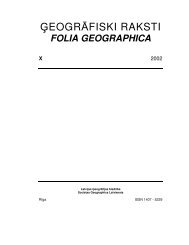eogrÄfiski raksti folia geographica xii - Ä¢eogrÄfijas un Zemes zinÄtņu ...
eogrÄfiski raksti folia geographica xii - Ä¢eogrÄfijas un Zemes zinÄtņu ...
eogrÄfiski raksti folia geographica xii - Ä¢eogrÄfijas un Zemes zinÄtņu ...
You also want an ePaper? Increase the reach of your titles
YUMPU automatically turns print PDFs into web optimized ePapers that Google loves.
LANDSCAPES AND CULTURE<br />
Writing Geography as Literature<br />
Edm<strong>un</strong>ds V. B<strong>un</strong>kše<br />
Abstract<br />
The idea of writing geography as literature was inspired by history. The question was asked,<br />
why is it some historians – Thucydes, Barbara Tuchman, Robert Hughes – have been able to<br />
write great histories that are also good literature? This essay examines how in Geography and<br />
the art of life, published by Johns Hopkins University Press in 2004, I attempted to do a<br />
geography that might also be literature, specifically a geosophy. The miscues and cues are<br />
examined during the evolution of the book, as well as the methodology that was involved.<br />
Geographic concepts and evolving landscapes perceptions were presented and interpreted in the<br />
light of personal experiences of war and exile. The varied and often ambiguous and<br />
contradictory meanings of home and road served as the leitmotifs. The method was inductive,<br />
with each chapter an exploration through the process of writing. Strict adherence to the principle<br />
of always favoring the geographic story over a chronology insured that the work was neither an<br />
autobiography nor a history. However, it also meant the sacrifice of some dramatic material that<br />
would have illuminated more completely the personal story.<br />
Key words: literature, home, road, geographic sensibilities, landscape perceptions.<br />
The inspiration<br />
The direct inspiration for writing geography as literature came during a conversation with Tim<br />
Unwin (a cultural geographer at the University of London at Egham) on board a small mail boat<br />
on the Norwegian Sea. It was 1998 and we were on the final leg of a field trip during a<br />
conference on European rural landscapes. It was an animated and far-ranging debate about<br />
geography, especially the intellectual freedom provided by its situation in both the arts and the<br />
sciences, but also its limitations as far as anything artistic is concerned. Why is it that some<br />
historians have been able to write great histories that are also great literature, we asked, but not<br />
geographers geographies? Thucydes’ The Peloponnesian war is still read today not only as<br />
history but also literature. There are my own favorites: The g<strong>un</strong>s of August by Barbara Tuchman<br />
(1962); The price of glory by Alistair Horne (1962); and Dudley Pope’s Decision at Trafalgar<br />
(1960). Robert Hughes’ The fatal shore: A history of the transportation of convicts to Australia,<br />
1787-1868 (1986) and Geoffrey Blainey’s The tyranny of distance: How distance shaped<br />
Australian history (1968) are good histories and good literature. To be sure, histories of wars,<br />
exploration, and settlement can make for great story telling. As for geography, we could only<br />
think of Humboldt’s Aspects of nature (1849) as an outstanding example of good, evocative<br />
writing in geography. The irony is that, however much Humboldt is regarded as one of the<br />
fo<strong>un</strong>ders of modern geography, it is his science that is tapped into, not his lyric, artistic<br />
evocations and perceptions.<br />
In the end we made a pact that each of us would write a book on geography that could be read<br />
as literature. Soon thereafter Tim was selected for an interesting high- level job by the British<br />
government and thus has not been able to work on such a book. I, however, was able to set to<br />
work almost immediately. This is the story of the trials that were involved and the methods<br />
employed in writing Geography and the Art of Life [B<strong>un</strong>kse 2004]. In the end the book turned<br />
out quite differently from what I had originally envisioned.<br />
Roots of the idea<br />
Roots of the idea of writing geography as literature reach much further back into my past than a<br />
conversation on the Norwegian Sea. They are discernible only in hindsight. As a child I had<br />
marveled at Jules Verne’s landscape evocations in Kapteina Granta berni (A translation in<br />
Latvian of The children of captain Grant—no date). Selma Lagerlof’s The wonderful adventures<br />
of Nils Holgerson (1920) was a captivating story and a lesson in geography about a miniscule<br />
boy traveling across Sweden on the back of a goose. Although I paid little heed to the specifics<br />
84

















